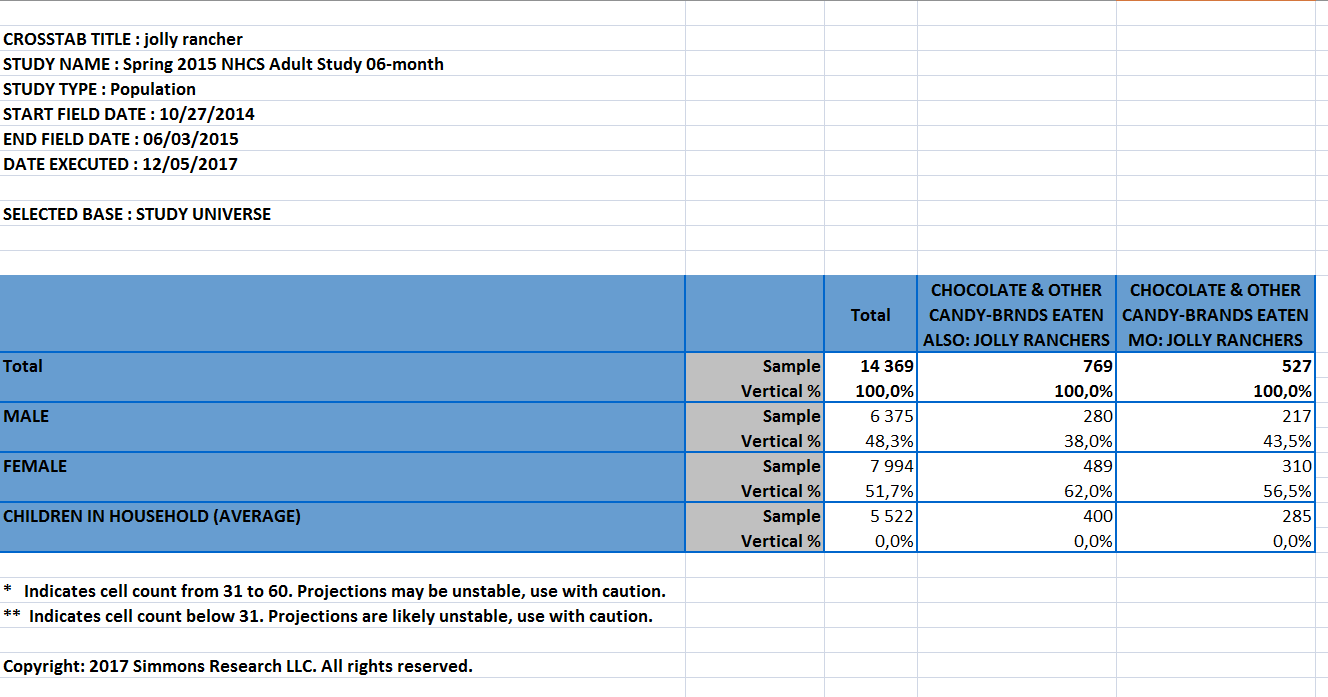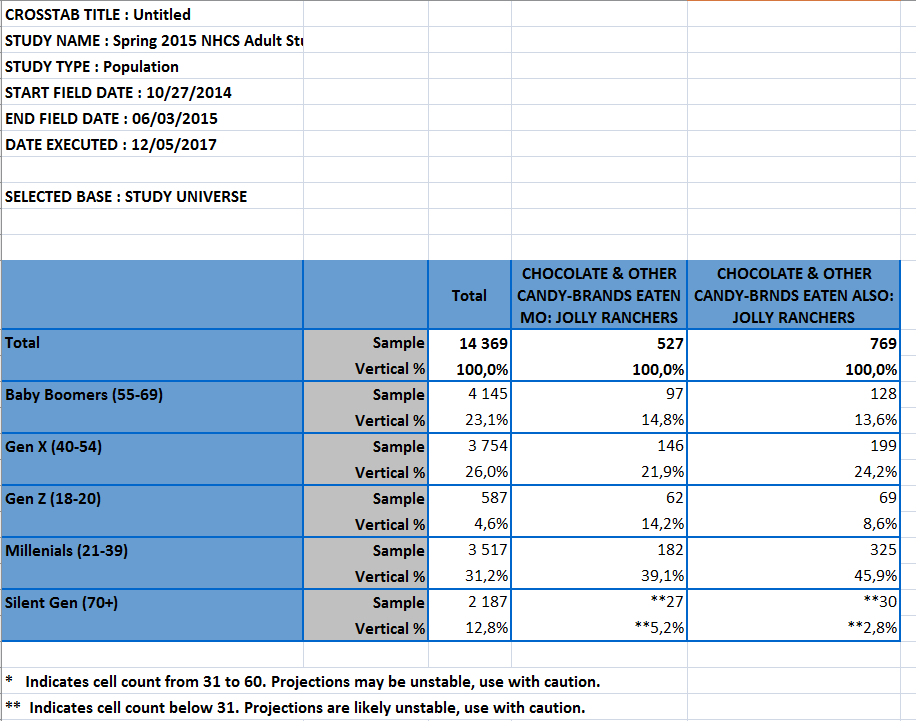Customer Segmentation
Demographics and Psychodemographics
A closer look at the customers that purchase Jolly Ranchers will show that the target audience is very diverse, with all age and gender groups being nearly equally represented in it. The people aged 35-45 outrank the rest by a very narrow margin (“U.S. Population”). Furthermore, the candy seems to attract the people from low-to-middle-class backgrounds most (“Jolly Rancher Consumer Insights”). Party stocking trips seem to be the primary reason for people to purchase Jolly Rangers (“Jolly Rancher Consumer Insights”). As Figure 1 provided below shows, the candy is currently much more popular among female customers than male ones (see Figure 1). Indeed, a sample of a total of 6,375 male buyers compared to 7,994 female customers seems a comparatively smaller demographic. Therefore, there is a need to introduce tools for attracting more male buyers. Furthermore, the fact that the majority of the participants did not have children (according to the test results, only 5,522 customers from the ample had kids) should be mentioned as one of the essential customer characteristics.

A closer look at the customers that purchase the product most often will show that Jolly Ranchers attract mostly Baby Boomers (4,145), Gen X (3,754) and Millenials (3,517), as Figure 2 shows. The specified phenomenon can be explained by the fact that the identified categories of buyers are likely to have families and, particularly, young children for whom they purchase the product.

Lifestyle, Values, and Behavior
As stressed above, the current average buyer of Jolly Ranchers can be described as a low-to-middle-class citizen. Since family stocking makes most of the basket sizes for Jolly Ranchers’ purchases, family-oriented values can be deemed as the focus of its customers. Furthermore, the people buying the candy seem to display a habitual buying behavior (Wang et al. 219). In other words, they purchase Jolly Ranchers because they are used to the identified brand and view the consumption of Jolly Ranchers as a part of their everyday meal.
Indeed, both Figure 1 and Figure 2 point to the fact that families with young children are likely to be the primary buyers of Jolly Ranchers. Therefore, it is crucial to mold the current marketing strategy to appeal to the identified demographics. The active use of images and ideas to which Generation X, Baby Boomers, and Millenials can relate should be viewed as a necessity.
Geography
Jolly Ranchers are very common in the U.S., as well as in North America, in general. However, with the opportunities that have opened for global trade with the recent IT innovations, Hershey now focuses on the global market as well.
Targeting
At present, it is imperative to focus on attracting customers from all backgrounds, including younger audiences, particularly, teenagers and young adults. At the same time, it is crucial to retain appeal for the people that make most of Hershey’s current buyers of Jolly Ranchers. For this purpose, the use of social networks to attract younger audiences successfully should be considered (Tiago and Verıssimo 705).
Product Positioning
Brand Personality
Jolly Ranchers have a very distinct brand personality. Hershey’s has created goofy characters that represent each flavor of the candy, thus, helping customers relate to the product faster. As a result, the brand has become memorable, and its taglines have been extremely quotable.
Brand Equity
When listing the qualities that make Jolly Ranchers stand out from a range of other products, one must mention quality standards first. According to the company’s statement, Jolly Ranchers are made of natural juice that has not been oxidized (“Jolly Rancher Hard Candy”). Therefore, the focus on keeping the product tasty and providing customers with unforgettable experiences must be deemed as Hershey’s success in creating brand equity for Jolly Ranchers.
Positioning
Product differentiation can be viewed as a tool that allows improving the positioning of Jolly Ranchers consistently. Particularly, the emphasis on new fruit flavors in the candy (e.g., “Watermelon”) can be viewed as a viable strategy for making the candy more attractive to customers.
Brand Strategies
One must give Hershey credit for taking a daring step and not being afraid of shocking its customers into paying attention to the company’s ideas. The use of “A New Media Model to Transform a Brand that Sucks” (Hart) is a change of pace for the organization, and it is evident that the firm is trying to appeal to a different demographics, particularly, the demographics that are referred to as “Millennials” (Hart). While the message might be deemed as dubious at first, the actual idea that underlies Hershey’s current strategy for branding Jolly Ranchers becomes quite sensible after scrutiny. It emphasizes the importance of being one’s true self and seeking eon’s own identity, the journey is accompanied by the taste of Jolly Ranchers. While the identified approach is sensible enough, it could use more elements that could attract the members of Generation X and Baby Boomers, though, since they also make a significant part of the target demographic.
Works Cited
Hart, Alan. “Jolly Rancher Gets ‘Fresh’ To Transform Hershey’s Marketing Model.” 2017, Web.
“Jolly Rancher Consumer Insights.” InfoScout. 2015, Web.
“Jolly Rancher Hard Candy.” Hersheys.com, 2017, Web.
Tiago, Maria Teresa Pinheiro Melo Borges, and Jose Manuel Cristovao Veríssimo. “Digital Marketing and Social Media: Why Bother?” Business Horizons, vol. 57, no. 6, 2014, pp. 703-708.
“U.S. Population: How Many Servings of Jolly Ranchers Chocolate and Other Candy Have You Eaten in the Last 30 Days?” Statista.com, 2017.
Wang, Rebecca, et al. “On the Go: How Mobile Shopping Affects Customer Purchase Behavior.” Journal of Retailing, vol. 91, no. 2, 2015, pp. 217-234.